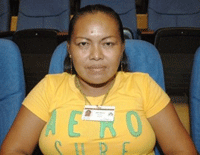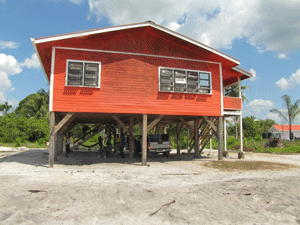MAICOPIK is a small lizard prevalent in Region Eight (Potaro-Siparuni) that has lent its name to an Amerindian village called Micobie.
 Interestingly enough, back when former Canadian Prime Minister, Pierre Trudeau visited Tumatumari the village was also called Cassava Hill and New Foundout.
Interestingly enough, back when former Canadian Prime Minister, Pierre Trudeau visited Tumatumari the village was also called Cassava Hill and New Foundout.
A subsequent village meeting however unanimously agreed that the village should be given its rightful name: Maicopik.
Trouble was, in the Official Gazette, it was misspelt Micobie, hence the name by which the village is now known.
Micobie is situated approximately two miles downriver of the famous Tumatumari Falls on the Potaro River.
It is accessible by road via the Linden/Mabura and Bartica/Potaro roads, or by aircraft to Mahdia, then by road. The journey by road involves approximately ten hours’ travel.
Each year, during the Amerindian Heritage Month of September, an Amerindian community is selected as the Heritage Village, and its residents are given the opportunity of sharing their way of life and achievements with the rest of Guyana.
Historical overture
According to Ovid Williams, a Patamuna tribesman who documented the history of Micobie, the village predominantly comprises of Patamuna People, said to be relatives of the Akawaios, who share many similarities, including language, diet, marriage rites and the practice of herbal medicine.
Micobie has been in existence since in the 1800s, when the now National Heritage, the Denham Bridge, was being constructed. Initially, the workers on the bridge and pork-knockers patronised the small community by purchasing their cassava bread, which is how the village came by the name, ‘Cassava Hill’.
The satellite village of Micobie is El Paso, located on the right bank of the Potaro River below the Tumatumari Falls.
In the 1960s, when captains were being elected to govern the community, one Mr. Bennett, of Arawak descent, was elected, and he changed the name from Cassava Hill to New Foundout.
Through the next Village Captain, Mr. Braithwaite, also of Arawak descent, the then very small village of Micobie forged a relationship with the Guyana National Service (GNS) and the Guyana Youth Corps stationed at Tumatumari, as ranks  there purchased ground provisions and cassava bread from the village.
there purchased ground provisions and cassava bread from the village.
In the 1800s, a family broke away from a community that was settled at Kangaruma, in the area now called Princeville, a satellite village of Campbelltown in the vicinity of Mahdia.
It was customary that farming and hunting grounds were the key forces in seeking ‘new lands’ for more comfortable livelihood, since, in that era, there was hardly any form of income-generating activity in comparison to present day.
Customs
Until his death in the late 1970s, the elder of the village, Mr. Isaac Williams, affectionately called ‘Uncle Isaac’, was one of the last remaining Piaimen of Region Eight.
A Piaiman is one who relies on his exclusive and in-depth traditional training in ‘high science’ to cure ailments and afflictions.
The legend of the Tumatumari Falls has eclipsed the history of Micopik by its very nature of being a warning signal.
Tuma is a popular meal of the Amerindian, and consists of boiled meat and hot peppers. When a family snares game, it is usually shared among the villagers; and for the morning meal, the host family would invite neighbours to dine with them by shouting, “Tuma! Tuma!”
Legend of the howl
Legend has it that sometimes on a moonless night, the Falls would make an eerie sound resembling the words “Tuma! Tuma!”
Villagers would interpret this call as a bad omen; and indeed there were natural disasters that followed such a howl, as someone would either drown in the Falls or the River. This is posited as how the Falls originally got its name Tumatumari.
The Aleluya religion (Indigenous religion) was practised in Micobie until the Anglicanism was introduced to the region.
Population
Micobie now has a population of approximately 360 persons. The village boasts a primary school, and students qualifying for secondary education would attend the nearby Mahdia Secondary School.
Economy
Because of its mineral and forest resources, Micobie had attracted a lot of private investors, but no infrastructure and skills were left when they moved on. The residents themselves are now engaged in small scale mining and, of course, their traditional farming.
Through presidential grants, Micobie benefited from a complete solar panel unit, a poultry production project, and a rest house in the community.
Governance
Governed by Toshao Julie Johnson, the grand-daughter of Mr. Isaac Williams, who heads six Councillors, Micobie’s guidelines for effective governance are outlined in the 2006 Amerindian Act.
In 2006, after lengthy consultations accompanied by procedural bottlenecks, Government awarded Micobie its land title for 24 square miles of land.
For a village with a humble beginning, it is now the task of the New Council, the descendants of “Uncle Isaac”, to assiduously work towards the betterment of Micobie.




.png)









